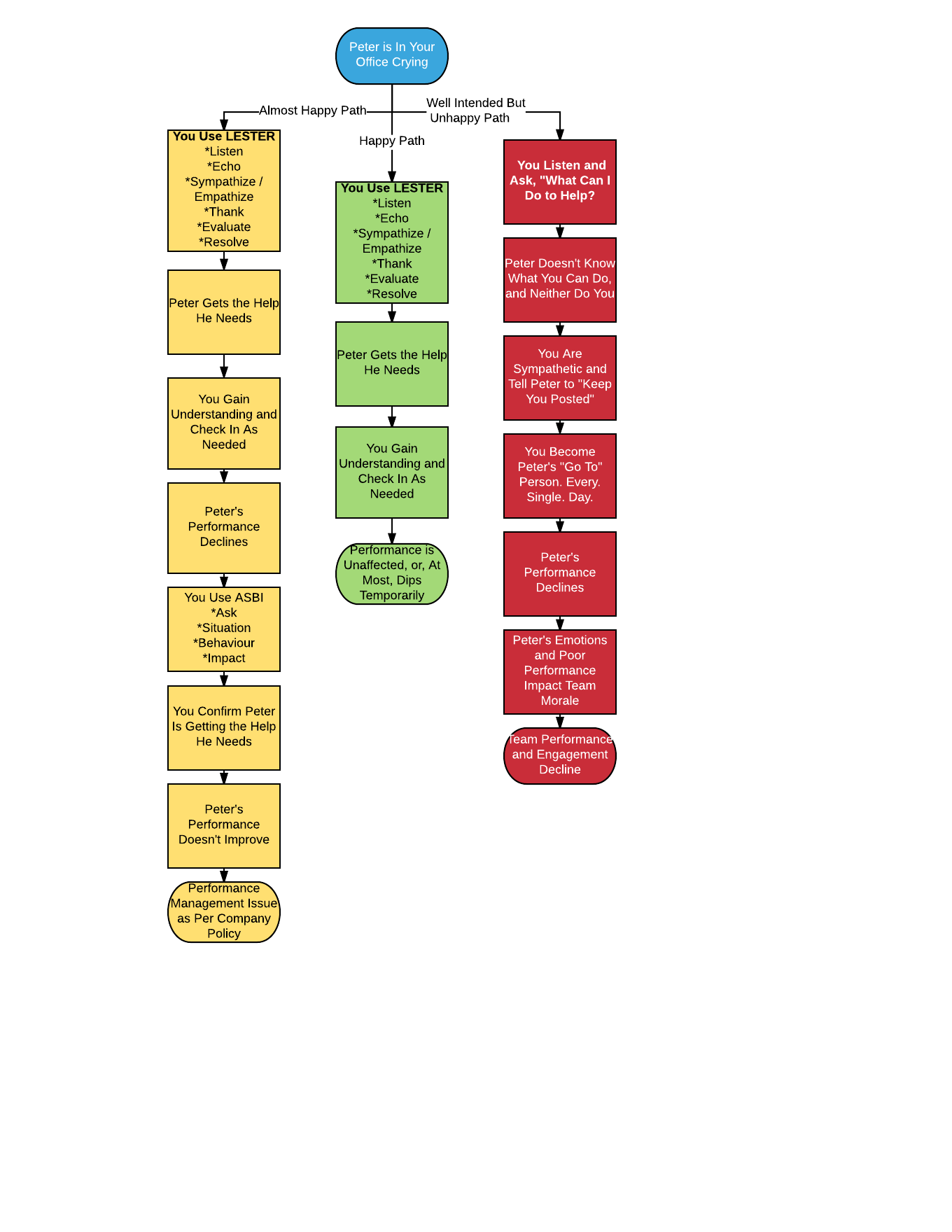Season Two, Episode Four. Podcast recap! (And if you missed the podcast, you can find it here.)
Podcast Recap: Season 2, Episode 4
Remember our poor imaginary employee Peter? Well, today we want you to imagine that he is now standing in front of you, in your office, weeping. He is distraught, using up your kleenex, and looking at you not know what to say or how to say it, and yet imploring you to help.
I guarantee that if you manage or supervise people, this has happened to you, or will happen to you some day, and you need to know what to do and how to handle the situation.
Shouldn’t Peter Leave His Troubles At Home?
Maybe 30 or more years ago, sure. Back then it was NOT ok to bring your troubles at work – you were expected to be a “big boy” or “big girl,” and “leave it at the door.”
Well, that’s not the case anymore. Now it is acceptable to “bring your whole self to work” and be who you are. If that’s not enough of a reason to hear Peter out, then here are three more reasons why you should make sure you know what to do if someone comes to you stressed out and/or emotional about something that has nothing to do with work:
- At the minimum, Peter will not perform well for you if something is causing him to become emotional in the workplace. And guess what – you are responsible for the performance of your team.
- You have a legal obligation, at least in Ontario and in many other places, to ensure that your employees are safe from bullying and harrassment, and this includes understanding whether there is an issue with domestic violence that could come to work. (See Bill 168 here.)
- It’s the right thing to do. As a human being it is appropriate to find out what is troubling this person and to make sure that they get the help and support they need. Note that this does NOT mean that you have to be their therapist!
OK, So What Do I Do Other Than Have Kleenex Ready?
Having an emotional person in your office is not unlike having an angry person, which we talked about a couple of episodes ago (read the blog recap here). It’s important to listen and convey understanding and empathy so that you can diffuse the emotion and get to the point where you can discuss what needs to happen. The LESTER tool works great for this!
- Listen. Don’t talk. Just listen.
- Echo. Repeat back what Peter said so you can confirm you know exactly what he’s upset about.
- Sympathize/Empathize. Let Peter know you know how awful this must be for him, and then move on to the next step. The danger here is to start swapping stories of when it happened to you. Suddenly you become like a therapist to Peter, and he’s in your office every day, and nothing is getting resolved.
- Thank. Tell Peter you’re glad he came to you.
- Evaluate. Consider some solutions to help. This is important: avoid saying, “What can I do to help?” This can result in Peter dumping things on you with great relief. Instead, ask “What needs to happen to help you through this?” Now Peter can own at least some of the responsibility of solving his own issues. (Note that depending on the issue you may want to check in with your HR department and let them know what’s going on, and just make sure you’ve done everything you should. They can be an excellent resource for you.)
- Resolve. Confirm the plan, follow up, and check in.
The key here is to ensure Peter is getting the help he needs, not let up on holding him (and yourself) accountable for any action steps, and for following up.
What if Peter’s Performance Doesn’t Improve, Even With My Help?
Well, the reality is that you are not Peter’s therapist, and you ARE responsible for your team’s performance.
If you have done everything you can think of to help Peter, and he is still not improving, then you will need to have a performance discussion. Here is where the ASBI tool will help you structure your conversation to be clear and direct:
- Ask for permission to have a discussion.
- Describe the situation.
- Describe the behaviour.
- Describe the impact.
This gives Peter the chance to understand that his performance is the issue (not his emotional concerns), and discuss how he can improve it.
If he STILL isn’t improving? Well, now you’re into a formal performance management conversation. Now is the time, if you haven’t already, to call HR and check your organizational policy on this. (If you don’t have an HR department, then check your company’s policy on this. Does Peter need time off?)
Remember, that helping Peter doesn’t mean you have to become a therapist. It means you have to be kind and curious, help Peter get the help he needs, and ensure that your team or organization’s performance isn’t jeopardized in the meantime.
Seek the Happy Path, always. You may end up on the “Almost Happy Path,” and that’s ok too. Just avoid the “Well Intended But Unhappy Path.” That is an energy drainer and doesn’t help anyone in the long run.
 Give these tips a try, let us know how it went on Twitter at @whiteboardcons and check out the rest of our podcast series on our homepage at www.whiteboardconsulting.ca.
Give these tips a try, let us know how it went on Twitter at @whiteboardcons and check out the rest of our podcast series on our homepage at www.whiteboardconsulting.ca.
Until next time,
Ruth.

